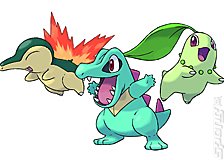
Way back in 1990, Satoshi Tajiri presented a virtually complete concept for a game inspired by his love of collecting insects as a child. After a further six years of intensive development, Nintendo launched two versions of a new game, Pokémon Red and Pokémon Green. At the time, the company had little idea what it was about to unleash.
Initial sales of these two titles were pretty slow at first, until Corocoro magazine – who published the Pokémon comic strip – revealed details of a mysterious Pokémon which seemed to appear at random in the game. The interest and publicity surrounding the Pokémon known as Mew – whose random appearances were due to a software glitch - gave a serious shot in the arm to game sales and by September 1996, Pokémons Red and Green had sold a million copies.
The first Pokémon cartoon was broadcast in Japan on April 1, 1997. In July 1998, the first Pokémon movie, 'Mewtwo Strikes Back' was released, and worldwide sales topped $36 million. This prompted the opening of a store solely dedicated to Pokémon in the heart of Tokyo.
In September 1998, Pokémon was introduced to America along with the cartoon series. Seven years down the line and a Pokémon theme park was opened for the first time in Nagoya, Japan, as part of the Expo 2005 in Aichi prefecture. Between March and September last year, there had been over 4.1 million visitors to the park. POKéPARK returns from June 2006 in Taipei, Taiwan.
By the end of 1999, Pokémon had officially become a cultural phenomenon in the west, the like of which the western media had never seen before. This funny little Japanese toy captured the hearts and minds of children and 'kidults' worldwide, with the games being developed into films, TV cartoons, toy ranges, pasta shapes and even a Pokémon branded jumbo jet.
Pokémon Ruby and Pokémon Sapphire on GBA have sold 15 million copies worldwide to date. Sales of Pokémon Fire Red and Pokémon Leaf Green on GBA, topped over nine million by the end of 2005. Pokémon Emerald, launched in October 2005 on the Game Boy Advance SP, reached sales of nearly five million worldwide by the end of 2005.
It is a clichéd and much-overused phrase in the world of videogame licensing, but Pokémon had really become a license to print money, with the worldwide Pokémon franchise estimated to be worth approximately $25 billion.
The Pokémon Trading Card Game has been one of the most popular non-videogame products, now distributed in 22 countries in Europe with local leagues and national championships. The Pokémon Company will also be launching its first Trading Figure Game this year, making its European debut in summer 2006, before any other territory.
The new Pokémon block puzzle game, Pokémon Link! launches across Europe on May 5, 2006.
Initial sales of these two titles were pretty slow at first, until Corocoro magazine – who published the Pokémon comic strip – revealed details of a mysterious Pokémon which seemed to appear at random in the game. The interest and publicity surrounding the Pokémon known as Mew – whose random appearances were due to a software glitch - gave a serious shot in the arm to game sales and by September 1996, Pokémons Red and Green had sold a million copies.
The first Pokémon cartoon was broadcast in Japan on April 1, 1997. In July 1998, the first Pokémon movie, 'Mewtwo Strikes Back' was released, and worldwide sales topped $36 million. This prompted the opening of a store solely dedicated to Pokémon in the heart of Tokyo.
In September 1998, Pokémon was introduced to America along with the cartoon series. Seven years down the line and a Pokémon theme park was opened for the first time in Nagoya, Japan, as part of the Expo 2005 in Aichi prefecture. Between March and September last year, there had been over 4.1 million visitors to the park. POKéPARK returns from June 2006 in Taipei, Taiwan.
By the end of 1999, Pokémon had officially become a cultural phenomenon in the west, the like of which the western media had never seen before. This funny little Japanese toy captured the hearts and minds of children and 'kidults' worldwide, with the games being developed into films, TV cartoons, toy ranges, pasta shapes and even a Pokémon branded jumbo jet.
Pokémon Ruby and Pokémon Sapphire on GBA have sold 15 million copies worldwide to date. Sales of Pokémon Fire Red and Pokémon Leaf Green on GBA, topped over nine million by the end of 2005. Pokémon Emerald, launched in October 2005 on the Game Boy Advance SP, reached sales of nearly five million worldwide by the end of 2005.
It is a clichéd and much-overused phrase in the world of videogame licensing, but Pokémon had really become a license to print money, with the worldwide Pokémon franchise estimated to be worth approximately $25 billion.
The Pokémon Trading Card Game has been one of the most popular non-videogame products, now distributed in 22 countries in Europe with local leagues and national championships. The Pokémon Company will also be launching its first Trading Figure Game this year, making its European debut in summer 2006, before any other territory.
The new Pokémon block puzzle game, Pokémon Link! launches across Europe on May 5, 2006.
Read More Like This
Comments
What? No mention of Gold or Silver? Those were the only real sequal in the Pokemon franchise. Everything else gave only marginal improvemnets to the game after that. What about Diamond and Pearl too? If I can't yell into my DS so that I throw the ball, or at least use a stylii to flick it out, then I am going to be peeved.
